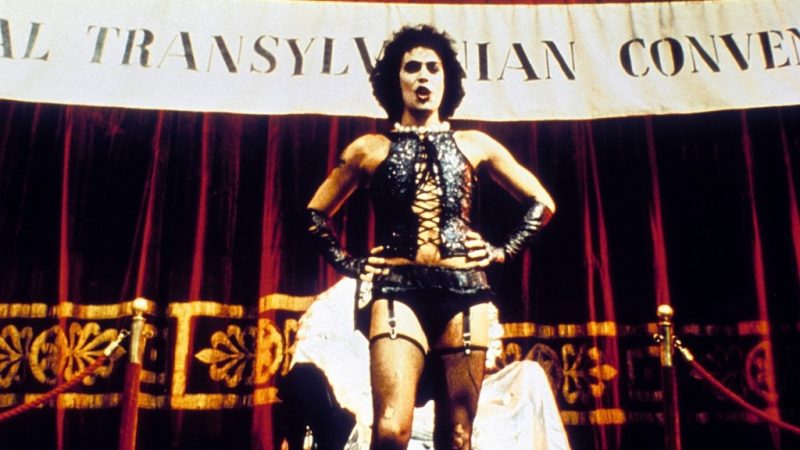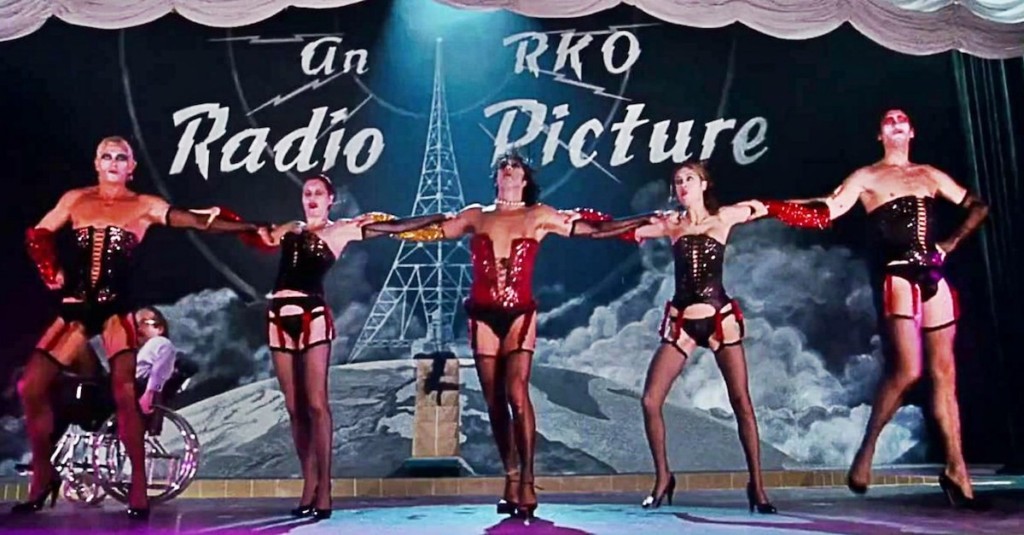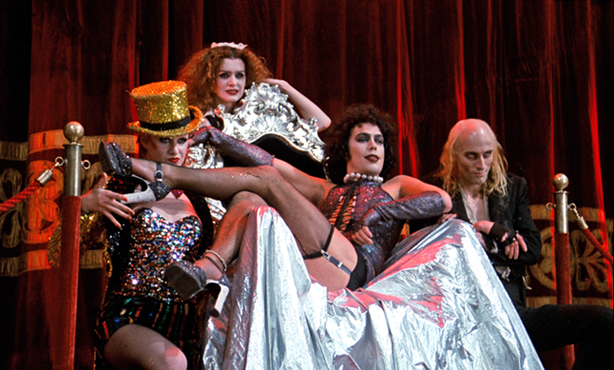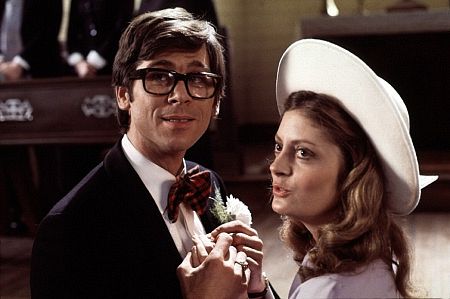RISE Housing and Support Services proudly presents The Rocky Horror Picture Show Fundraising Event! RISE chose Rocky Horror as the center of our signature fundraising event because of the positive impact it had (and continues to have) on individuals who have been made to feel alien, outside, or even outcast from society. For more details and to purchase tickets visit: The RISE Rocky Horror Picture Show Fundraising Event.

Rocky Horror is a Cultural Phenomenon
The Rocky Horror Picture Show is not so much a movie as it is a cultural phenomenon. The campy science-fiction musical has been a facet of queer culture since the late 1970s and has had a deep impact on pop culture.
Rocky Horror was absolutely shocking for a 1970’s film, but has cemented itself in the queer community and culture and is definitely here to stay. Assuredly, many people write it off immediately due to its tacky sci-fi plot. And to some the “Sweet Transvestite from Transsexual Transylvania” line sounds offensive or triggering. However, Rocky Horror not only supported queer individuals who were closeted or harassed – it made everyone question their identity, orientation, and lifestyles in a way they never had before.
A Transgender Alien Looking for Acceptance
At first glance, The Rocky Horror Picture Show seems like a nonsensical film about an insane cannibalistic transgender scientist who tortures innocent people, but is simultaneously a story about a transgender alien (Dr. Frank-N-Furter) who has left his home planet looking for a place where his queer desires will be accepted.

He travels from planet to planet, but they are all the same, and he is consistently rejected. Finally, he lands on Earth and discovers how to create life. He uses these powers to create a human companion for himself, Rocky Horror, but this cross-species relationship offends the aliens from his home planet, who kill him. The film ends with a lament about how Earth, without the transgender figure of Frank N. Furter, is “lost in time, and lost in space/and meaning.”
Rocky Horror and the 1970’s Queer Movement
With the Stonewall Riots taking place in 1969, the 1970’s were a coming of age for the civil rights movement of the LGBTQIA+ community. The LGBTQIA+ Community and sexual liberation flourished in the ’70s, and Rocky Horror delves into topics that were considered taboo before it, topics like self-discovery and self-actualization. By openly displaying sex, sexual humor, and LGBTQIA+ representation, RHPS sent a surge of liberation through the 1970s that continues to reverberate, inspiring LGBTQIA+ people to this day. The film is a celebration of the gay community.

The world depicted in the Rocky Horror Picture Show clearly matters to many people, and this appreciation has much to do with its context. The original play came about in London in 1973, when there wasn’t as much acceptance for either LGBTQIA+ people or sexual empowerment. Same-sex marriage wasn’t legalized until the 2010s, and the concept of monogamy was very much the dominant cultural narrative (and remains so today). RHPS cut across these tensions by boldly talking about sex and queerness — all within a fun, campy package that satirized the B-movies of the 1950s.
Rocky Horror also addresses the feeling of isolation – a very familiar feeling to much of the queer community at the time. Dr. Frank-N-Furter is born and then dies in a world that hates him. Those emotions of self-pity and despair are buried underneath the levity of the movie. In the song I’m going home, Dr. Frank-N-Furter describes how they were rejected from their original birthplace. They have since then been drifting aimlessly through the cosmos.
For a long time, there were many parts of the country where the midnight showings of RHPS was one of the only SAFE queer spaces that existed. These showings have been key in helping many people assert their identities. This fact is especially true when the LGBTQIA+ community has traditionally had so few non-bar-related scenes for queer people to explore.
A Villain CAN be a Decent Representation
Rocky Horror not only portrays a loud, proud Dr. Frank-N-Furter who is shown to be stunning and attractive to both Janet and Brad, but it also quite clearly depicts the polycule* relationship between several of the characters: Frank, Magenta, Riff Raff, and Columbia.
*Polycule – a connected network of people in a non-monogamous relationship. Used by the polyamory community.

Dr. Frank-N-Furter, who is first introduced to the audience as a bold, gender non-conforming individual in the song Sweet Transvestite, singing “I’m just a sweet transvestite from Transexual, Transylvania.” Dr. Frank-N-Furter’s unabashed confidence was, at the time, a rare type of representation for a trans character in mass media. Dr. Frank-N-Furter’s unabashed confidence was, at the time, a rare type of representation for a trans character in mass media. Their commanding presence made them a fixture in pop culture that many people have since wanted to replicate. His charisma is alluring, fun, and portrayed in a lighthearted, humorous way.
However, in recent years, some have questioned the character’s status as a prominent figure of sexual awakening and exploration, based on concerns that he falls into a trope of trans “deviancy” that ties directly into decades of discrimination on the Silver Screen and off. And yet, Dr. Frank-N-Furter is not entirely hateable either. They are a fun and witty character, and that makes them a great watch. Though sometimes this is done voyeuristically by straight, cis-gendered people who want to gawk at the gender-nonconformity.
Then why is Dr. Frank-N-Furter – a questionable character – considered to be a representative of the queer community? Well despite Dr. Frank-N-Furter being a villain, it’s the way they are portrayed that’s different. They’re fun. They’re funny. They’re alluring. They have depth and complexity. And when they are betrayed at the end of the film – the audience is left gutted. Columbia and Rocky both weep. Brad and Janet are saddened. They aren’t just another queer-coded villain included for morality’s sake.
Brad and Janet: Self-Discovery
The Rocky Horror Picture Show delves into topics like self-discovery and self-actualization with the sappy lead characters, Brad and Janet.

Brad ends up confused in the typical mid-century male role that he’d never questioned before when suddenly he is attracted to another man and feels beautiful dressing in stockings and wearing makeup. It’s scary, it’s new, yet he loves it.
Janet similarly is shown as something other than a doting, devoted housewife – she experiences liberation in her own sexuality, and expresses love for her body. Exploration and independence in relationships was something that nobody was encouraged to do then – most especially women.
The Concept of Consent
Through a 2022 lens, the depiction of consent (or lack thereof) is especially problematic. At the time, the modern notion of consent had just started to enter the popular lexicon. The year RHPS first aired, the concept of “date rape” had just entered the national conversation. This cruel reality meant that it wasn’t considered unusual in the 1970s for consent to be murky in US pop culture and real-life. RHPS was a product of its time as explicit consent is non-existent in many of its scenes. For example, Brad and Janet first come to Dr. Frank-N-Furter’s castle to use the doctor’s telephone, and instead, he has them stripped down to their undergarments. Brad “decides” to accept this situation, but only as a transactional means to an end.
Later, the mad scientist separately visits both Brad and Janet in bed under the guise of pretending to be the other’s partner. They effectively trick each member of the couple into having sex with them, and although they do later consent, the initial engagement is quite predatory. This point is particularly troublesome as trans community has often faced false accusations of “trapping” their partners into sexual relationships.
So while we cherish RHPS as a landmark film for the queer community, we also want to acknowledge the problematic plot points around consent that are a reflection of the world as it existed at that time.
The information for this post has been taken from the following sources:
Why The Queer Community Loves The Rocky Horror Picture Show
Gently Ripping Apart ‘The Rocky Horror Picture Show’
In Praise of the Bad Transgender Object: Rocky Horror
